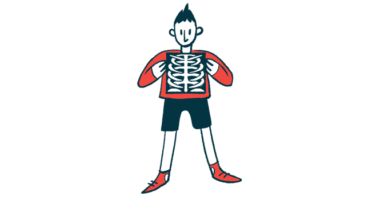Tarlov Cyst Leads to Bladder, Bowel Incontinence in Pediatric EDS Case
Researchers say case illustrates need for early screening, treatment

A Tarlov cyst, a fluid-filled sac in the spine that may rarely occur as a complication of Ehlers-Danlos syndrome (EDS), caused long-lasting loss of bladder and bowel control (incontinence) in a boy with hypermobile EDS, a study showed.
While several cases of Tarlov cysts in adults with EDS have been reported, this is thought to be only the second reported case in a pediatric patient.
The case supports screening EDS patients for symptoms of incontinence and other neurological signs to identify spinal cord involvement, and treating a potential Tarlov cyst earlier, the researchers noted.
It’s possible that early detection and treatment of the cyst could have prevented symptom progression and led to a full resolution of the boy’s incontinence, which did not occur, the researchers said.
The report, “A Case of a Tarlov Cyst in a Pediatric Patient With Ehlers-Danlos Syndrome,” was published in Cureus.
Hypermobile EDS is the most common type of EDS. Patients may have unusually mobile, or hypermobile, joints that dislocate easily, joint pain, fragile skin that breaks or bruises easily, and scoliosis (an abnormally curved spine).
Some patients may also have neurological complications — musculoskeletal pain, fatigue, muscle weakness, involuntary muscle contractions, and paresthesia (numbness or prickling sensations).
A rare neurological complication of EDS is a Tarlov cyst, a sac filled with liquid that surrounds the brain and spinal cord and most often grows at the sacrum, a bone at the bottom of the spine.
The cyst can press on nerves, causing sacral pain, sciatica, and urinary and bowel incontinence. Sciatica is a shock-like or burning pain that runs from the lower back and down the back of the legs.
Tarlov cysts rare in pediatric EDS cases
“Tarlov cysts in the pediatric population are a rare phenomenon,” the researchers wrote, adding that among EDS patients, some cases have been reported in adults, but only one case has been reported to date in a child.
Researchers at Rowan University School of Osteopathic Medicine, Stratford, New Jersey, described the rare case of a Tarlov cyst in an 11-year-old boy with hypermobile EDS who developed urinary and bowel incontinence.
At age 9, the boy went to a hospital with urinary incontinence and bed-wetting, having had frequent urinary and bowel incontinence for the past two years, for which medicine to treat symptoms of an overactive bladder was given.
Magnetic resonance imaging (MRI) revealed a tethered spinal cord, meaning it was abnormally attached to the surrounding tissues of the spine, and a Tarlov cyst in the sacrum.
At age 10, the boy underwent surgery to remove the cyst and part of the two affected sacral vertebrae (the small bones that make up the spine) to relieve pressure on the spinal cord and remove tissue attachments.
Symptoms of urinary and bowel incontinence were rapidly reduced and continued to ease for up to about six months.
However, about a year later, at age 11, the boy’s urinary incontinence returned, happening up to five times a week and worsened with daily activities. In addition, he reported lower back pain and numbness and prickling sensations.
New MRI scans showed no Tarlov cyst, but a tethered spinal cord was seen in the same region that was missed in the previous scan. The boy underwent another surgery to remove the remaining tissue attachments causing the tethered spinal cord.
After surgery, he reported improvements in mobility and reductions in lower back pain, abnormal sensations, and radiating pain down the legs.
The boy continued to have some urinary and bowel incontinence as well as nerve pain, however, which are being managed with appropriate medication.
“This case delineates the significance of recognizing the diagnosis of the Tarlov cyst in children with a history of EDS,” the research team wrote, adding that it also “raises the question of whether earlier diagnosis and treatment could have prevented the progression of symptoms.”
“We recommend screening patients with EDS for symptoms of incontinence, lower extremity paresthesia, and pain to recognize underlying spinal cord involvement,” the researchers wrote. “Identifying the disease early on can help intervene medically or surgically to ameliorate symptom severity.”







